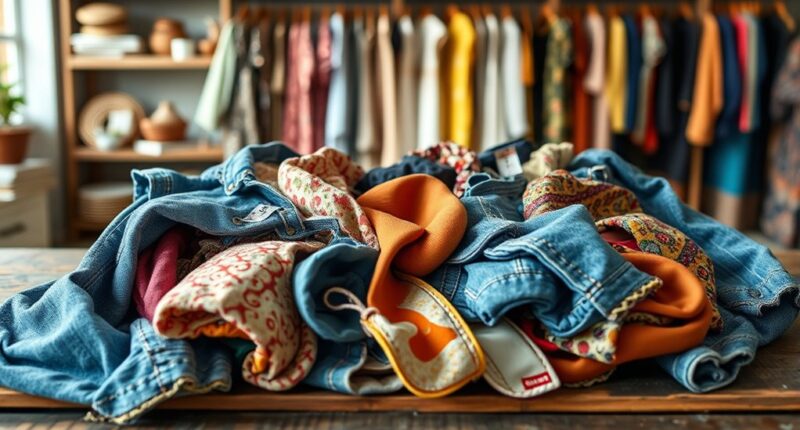Circular fashion changes how you approach clothing by focusing on resale, upcycling, and renting. These practices help extend the life of garments, reduce waste, and lower environmental impact. By participating in resale platforms, you can give pre-owned clothes a new life. Upcycling transforms old pieces into unique items, while renting offers a sustainable alternative to buying for special occasions. Keep exploring to discover how these habits can transform your wardrobe and support a more responsible fashion industry.
Key Takeaways
- Resale platforms extend garment life cycles by enabling secondhand sales of designer and everyday clothing.
- Upcycling transforms old garments into new, unique pieces, minimizing textile waste.
- Renting clothes for special occasions reduces demand for new clothing production and promotes sharing.
- These practices support a circular economy, encouraging sustainable consumption and resource efficiency.
- Combining resale, upcycling, and renting fosters an industry shift toward eco-friendly and socially responsible fashion.

Have you ever wondered how the fashion industry can become more sustainable? It’s a question more people are asking as the environmental and social impacts of fast fashion become harder to ignore. One of the most promising ways to make fashion more eco-friendly is through innovative approaches like resale, upcycling, and renting clothes. These practices reduce waste, extend the life cycle of garments, and lessen the demand for new production. But to truly transform the industry, the focus must also be on sustainable textile innovations and ethical labor practices. These elements ensure that sustainability isn’t just a trend but a deeply rooted change in how clothes are designed, produced, and consumed.
Sustainable fashion relies on innovative resale, upcycling, and ethical practices to create lasting environmental and social change.
Sustainable textile innovations are at the forefront of this movement. Think of fabrics made from recycled plastics, organic cotton, or biodegradable fibers. These materials lessen the dependence on environmentally damaging resources and lower greenhouse gas emissions. When you choose clothes made from sustainable textiles, you’re supporting advancements that prioritize eco-friendly production methods. Additionally, brands committed to ethical labor practices ensure that workers are paid fair wages and work in safe conditions. This commitment tackles social issues head-on, making sure that your fashion choices don’t come at the expense of someone else’s well-being.
Resale platforms make it easy for you to find pre-owned designer pieces or everyday essentials, giving clothes a second life rather than ending up in landfills. By buying secondhand, you’re not only saving money, but you’re also reducing the demand for new manufacturing. Upcycling takes this a step further by transforming old or discarded garments into new, unique pieces. Imagine turning an outdated t-shirt into a trendy tote or reconstructing worn-out jeans into stylish shorts. This creative process minimizes waste and encourages you to see clothing as a resource rather than disposable goods.
Renting clothes offers another sustainable alternative. Instead of purchasing a new outfit for a special event, you can rent high-quality garments for a fraction of the cost. This practice considerably cuts down on the environmental impact of producing one-time-use fashion. Plus, it promotes a culture of sharing and circularity, where clothes are circulated among many users instead of being discarded after a single wear. When you participate in rental programs, you contribute to reducing textile waste and supporting a more sustainable fashion economy.
Moreover, fostering a growth mindset around fashion consumption can help consumers embrace more sustainable habits and see clothing as a long-term investment. Ultimately, embracing resale, upcycling, and renting aligns with a broader shift toward sustainable textile innovations and ethical labor practices. It’s about making conscious choices that prioritize the planet and the people who make our clothes. By doing so, you help foster a fashion industry that’s not only stylish but also responsible and resilient for future generations.
Frequently Asked Questions
How Does Circular Fashion Impact Global Textile Waste Reduction?
Circular fashion profoundly reduces global textile waste by promoting textile recycling and encouraging you to buy, sell, or rent pre-loved clothes. When you participate in these practices, you help extend the life of garments and minimize landfill waste. Increasing consumer awareness about the environmental impact of fast fashion motivates you to make sustainable choices, ultimately decreasing the amount of textile waste generated worldwide and fostering a more eco-friendly fashion industry.
What Are the Most Sustainable Materials Used in Circular Fashion?
You’ll love eco-friendly fibers like organic cotton, which minimizes chemical use and supports sustainable farming. Imagine a brand using biodegradable textiles that naturally decompose after use, reducing waste. These materials are the most sustainable choices in circular fashion because they’re renewable, biodegradable, and leave a smaller environmental footprint. By choosing products made from these fibers, you actively contribute to a greener, more sustainable fashion industry.
How Can Consumers Best Participate in Circular Fashion Practices?
To participate in circular fashion practices, you should focus on consumer education and seek brand collaborations that promote sustainability. Stay informed about eco-friendly materials and recycling options. When shopping, choose resale, upcycled, or rental platforms. Support brands committed to circular principles. You can also extend your clothes’ life through proper care and recycling. Your active involvement helps reduce waste, conserves resources, and encourages brands to prioritize sustainable practices.
What Are the Challenges Faced by Resale and Upcycling Platforms?
You might think resale and upcycling platforms face few hurdles, but market transparency and quality assurance are real challenges. You could struggle with verifying the authenticity of items or ensuring consistent quality, which affects trust. Limited market transparency also makes it hard for you to assess fair prices or the platform’s sustainability claims. Overcoming these issues requires stricter standards, better tracking, and clear communication to build your confidence in circular fashion options.
How Does Circular Fashion Influence Traditional Garment Manufacturing?
Circular fashion pushes traditional garment manufacturing toward supply chain innovation and design for longevity. You’ll find brands adopting sustainable materials and creating pieces meant to last longer, reducing waste. This shift encourages manufacturers to rethink their processes, prioritize durability, and develop closed-loop systems. As a result, traditional manufacturing becomes more sustainable, focusing on quality over quantity, which ultimately benefits both the environment and consumers seeking timeless, eco-friendly clothing options.
Conclusion
Think of circular fashion as a garden where your clothes grow, flourish, and are reborn. By embracing resale, upcycling, and renting, you become a gardener nurturing sustainability instead of depleting resources. Every choice you make is like planting a seed for a greener future—your actions sprout change that can bloom globally. So, step into this cycle with purpose, knowing that your wardrobe can be a garden of endless possibilities and renewal.









